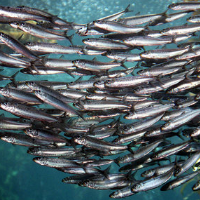Sardines Fall Way Below Minimum Numbers; Fishing Finally Banned
 Sardines (photo: Chuck Kermin, Ventura County Star)
Sardines (photo: Chuck Kermin, Ventura County Star)
In May 2014, the National Oceanic and Atmospheric Administration (NOAA) announced that one of the likely contributors to the death of 1,600 California sea lions was the absence of sardines. Oceana, an international ocean conservation and advocacy organization, continued a warning it had begun eight years before:
“NOAA failed to recognize that the sardine fishery had anything to do with the scarcity of sardines and instead is diverting resources and public attention to solely addressing the symptom of the problem by rehabilitating pups and returning them to the wild, without also allocating resources to address the root cause of the problem; continued overfishing.” (emphasis added)
Now, 11 months later, the Pacific Fishery Management Council has snapped into action, and on Monday shut down next season’s sardine fishing season that begins July 1. The council is scheduled to consider taking emergency action on current fishing Wednesday.
The crucial forage fish’s population is known for being chronically volatile, but its drop from a high of 1.42 million metric tons in 2007 to 97,000 by next season has become hard to ignore. The council website says, “When the biomass estimate falls to the level of 150,000 metric tons, commercial sardine fishing is essentially shut down.”
Oceana sued the council in 2011 over what it considered excessive fishing but lost. A report that year in the Proceedings of the National Academy of Sciences forecast “a collapse of the sardine stock.” They were right, but it’s not the first.
The industry, which was the background for author John Steinbeck’s tale about Depression Era Cannery Row in Monterey, busted in the mid-1940s, bounced back in the 1990s and began declining sharply eight years ago.
Fishermen claim the number of sardines is being undercounted, and declines could be explained by a range of nonhuman activities, like El Nino. Dianne Pleschner-Steele, executive director of the California Wetfish Producers Association, told the Monterey Herald, “Fishing has a minimal impact. It does have some. In the long term, this fishery is managed excruciatingly precautionary,”
Geoffrey Shester, Oceana’s California campaign director, disagrees. He said the damage would be felt for decades and told the San Francisco Chronicle, “There’s a management failure here. They didn’t respond fast enough to the decline. Now we find ourselves in the crisis situation.”
“Crisis?” Who says it’s a crisis? The council says it “takes a precautionary approach to sardine management” and emphasizes the importance of environmental influences: “Sardine productivity is generally linked to ocean temperatures.”
But the council also acknowledges that something strange has been happening recently to the fish, which tend to like warmer waters: “Temperatures in the Southern California Bight have ticked up the past two years but we haven’t seen an uptick in young sardines that was expected.”
Sardine distress can be an early indicator of more widespread problems. They are a key food group for animals other than sea lions. Seals, elephant seals, humpback whales, salmon, tuna, birds, marine mammals and others chow down on the fatty little fish.
Sea lion deaths have continued to grow. More than 2,250 starving pups have ended up dead along the West Coast so far this year.
Sardine fishing is big in Northern California, Oregon and Washington and extremely important to some communities, but it is not a mega-industry, with annual revenues around $20 million. Around 100 boats have permits to fish for sardines, less than half the number at the peak. The fish is sold mostly as bait.
Although fishermen, environmentalists, government functionaries and other observers are looking at pretty much the same set of facts surrounding the rapid decline of sardines, starvation of sea lion pups and other mass die-offs, there is scant agreement among them as to the cause.
–Ken Broder
To Learn More:
Sardine Population Collapses, Prompts Ban on Commercial Fishing (by Peter Fimrite, San Franciso Chronicle)
Feds Lower Boom: No Sardine Fishery Next Year (by Jason Hoppin, Monterey County Herald)
Oceana Takes Small Win, Bigger Loss in Forage Fish Lawsuit (by Kera Abraham, Monterey County Weekly)
Feds Likely to Shut Down Sardine Fishing on West Coast (by Jeff Barnard, Associated Press)
Bad News on the West Coast: Pacific Sardines Are Collapsing (by Paul Shively, The PEW Charitable Trusts)
West Coast Sardine Crash Could Radiate Throughout Ecosystem (by Tony Barboza, Los Angeles Times)
Sea Lion Deaths Blamed on Sardine Shortage, but Nothing Done about Overfishing (by Ken Broder, AllGov California)
Council Votes to Close 2015-2016 Pacific Sardine Fishery (Pacific Fishery Management Council)
- Top Stories
- Controversies
- Where is the Money Going?
- California and the Nation
- Appointments and Resignations
- Unusual News
- Latest News
- California Forbids U.S. Immigration Agents from Pretending to be Police
- California Lawmakers Urged to Strip “Self-Dealing” Tax Board of Its Duties
- Big Oil’s Grip on California
- Santa Cruz Police See Homeland Security Betrayal in Use of Gang Roundup as Cover for Immigration Raid
- Oil Companies Face Deadline to Stop Polluting California Groundwater





